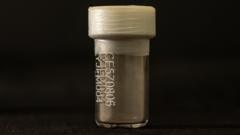The first Moon rock samples brought back to Earth in nearly half a century have landed in the UK, courtesy of a loan from China. Housed in a secured facility in Milton Keynes, these extraordinary specks of lunar dust are an exciting development for the scientific community. Professor Mahesh Anand, the only British scientist granted access to these rare materials, has referred to them as "more precious than gold dust."
Having traveled to China to retrieve the samples, Professor Anand's research team aims to delve into fundamental questions regarding the Moon's formation and explore the early history of Earth. The samples, which contain evidence supporting the theory that the Moon was formed from debris resulting from a collision between Earth and a Mars-sized planet 4.5 billion years ago, were collected during China's Chang'e 5 space mission in 2020.
The mission, which involved drilling into lunar soil at Mons Rümker, not only marked China's significant achievement in the space race but also solidified its status as a leader in modern astro-research. The dust samples were made accessible to seven international researchers for collaborative study, highlighting a growing tradition of global cooperation in space exploration.
During a grand ceremony in Beijing, Professor Anand received the samples, noting China's substantial investments in their space program. Upon his return to the UK, he traversed through security protocols, including wearing protective gear to ensure the preservation of the samples free from contamination—an essential step since Earth's materials could compromise the results of their studies.
The lunar dust is contained within small, carefully sealed vials, each holding a mere 60mg, yet Professor Anand emphasizes that even this tiny amount will be sufficient for extensive research. In the laboratory, technician Kay Knight prepares to work on the samples, expressing excitement and trepidation over the high-stakes nature of handling such a rare find.
Professor Anand and his team plan to employ advanced technology, including a customized machine capable of analyzing the samples at high temperatures to extract essential elements. The research is set to last a year, and will likely consume the samples during the process, but the insights they gather could open up entirely new avenues in lunar science.
Looking to the future, Professor Anand hopes for ongoing collaboration between China and other nations in lunar exploration. He reminisced on how many scientists built their careers working with Apollo samples, and suggested that sharing valuable resources could foster similar breakthroughs in scientific discovery. As China prepares for future missions, including the Chang'e 6, which will collect samples from the Moon's far side, the excitement and potential for groundbreaking research continue to grow.
Having traveled to China to retrieve the samples, Professor Anand's research team aims to delve into fundamental questions regarding the Moon's formation and explore the early history of Earth. The samples, which contain evidence supporting the theory that the Moon was formed from debris resulting from a collision between Earth and a Mars-sized planet 4.5 billion years ago, were collected during China's Chang'e 5 space mission in 2020.
The mission, which involved drilling into lunar soil at Mons Rümker, not only marked China's significant achievement in the space race but also solidified its status as a leader in modern astro-research. The dust samples were made accessible to seven international researchers for collaborative study, highlighting a growing tradition of global cooperation in space exploration.
During a grand ceremony in Beijing, Professor Anand received the samples, noting China's substantial investments in their space program. Upon his return to the UK, he traversed through security protocols, including wearing protective gear to ensure the preservation of the samples free from contamination—an essential step since Earth's materials could compromise the results of their studies.
The lunar dust is contained within small, carefully sealed vials, each holding a mere 60mg, yet Professor Anand emphasizes that even this tiny amount will be sufficient for extensive research. In the laboratory, technician Kay Knight prepares to work on the samples, expressing excitement and trepidation over the high-stakes nature of handling such a rare find.
Professor Anand and his team plan to employ advanced technology, including a customized machine capable of analyzing the samples at high temperatures to extract essential elements. The research is set to last a year, and will likely consume the samples during the process, but the insights they gather could open up entirely new avenues in lunar science.
Looking to the future, Professor Anand hopes for ongoing collaboration between China and other nations in lunar exploration. He reminisced on how many scientists built their careers working with Apollo samples, and suggested that sharing valuable resources could foster similar breakthroughs in scientific discovery. As China prepares for future missions, including the Chang'e 6, which will collect samples from the Moon's far side, the excitement and potential for groundbreaking research continue to grow.


















